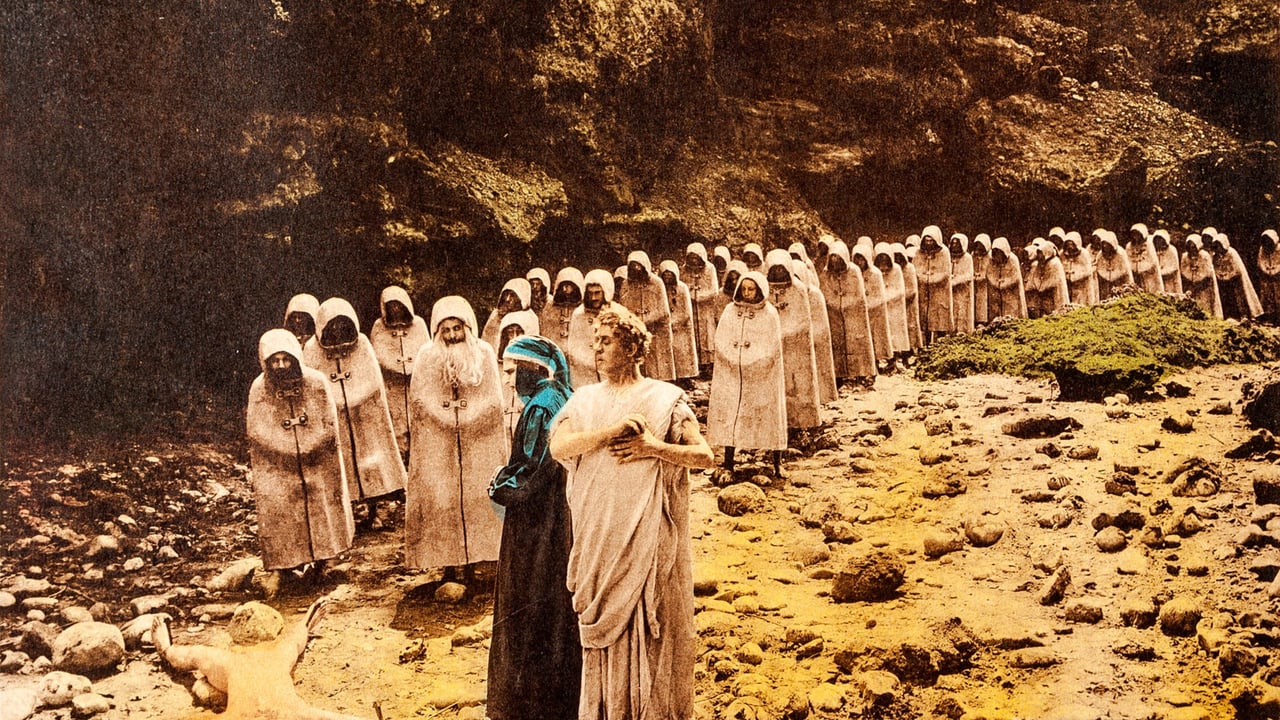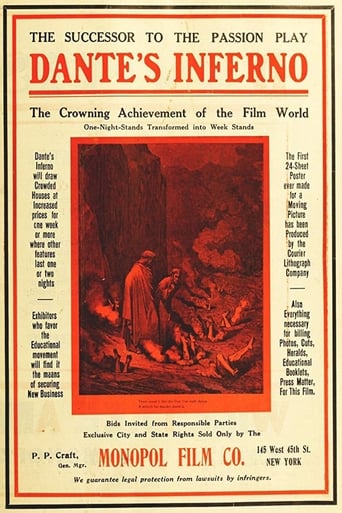

Gripping story with well-crafted characters
... View MoreIt's fun, it's light, [but] it has a hard time when its tries to get heavy.
... View MoreOne of the best movies of the year! Incredible from the beginning to the end.
... View MoreAll of these films share one commonality, that being a kind of emotional center that humanizes a cast of monsters.
... View MoreFrequently classed as the first "blockbuster" of its time because of its large production budget, long runtime and higher-than-average ticket costs at the box office, L'Inferno adopts Dante's prose and brings its pages to life with some decent production values helping it along the way. As far as adaptations go, the movie is fine and features a handful of impressive shots and sequences. The tone is brooding and somewhat haunting, which is appropriate given the source material. The problem though is that it's drawing from a book that (as far as I can fathom) is highly regarded for its lyrical beauty as opposed to its storytelling. Despite the film's best intentions then, you're nevertheless left to watch a bunch of scantily-clad white people faff around for 80 minutes either getting burned to varying degrees or flailing around in some water for whatever reason while another white guy (Dante) has a day-trip through hell in order to feel good about himself by looking down on and deriding the "sinners". For what it is, it's a somewhat interesting watch, but only for historical purposes. Well, that and to make you aware that as long as your sins are lust, gluttony, or fraud, things could be worse.
... View MoreA person visits a dirty ghetto and a hill without trees. The people living in the ghetto are mostly naked, jumping up and down sometimes. Note that the ghetto is not dark, or frightening, or disgusting. It's simply tasteless and boring. You call this Hell? Hell is a place that's exciting. You don't fall asleep while watching the images of it.I am not trying to be rude, as this is said to be the world's second feature-length "movie", made in 1911. But after taking a look at those great paintings on this topic, created hundreds of years before this "movie", it becomes impossible to understand what the people creating this were up to.Well, maybe in 1911, anything can be considered a great movie, as long as it shows things that are not still.
... View MoreL'inferno is a pretty early feature length film. In fact it's one of the earliest that still exists today. 1911 is more than hundred years ago and the impact of all that time shows in the movie. It's highly unlikely that they'll ever make something like this again. A Mayor production with a lot of naked people suffering the tortures of hell is a no-no today AND THAT'S A SHAME because this movies gives one of the best and most outright visualizations of hell there has ever been. The movie takes Dante's portrait of hell and puts it on the screen in big fashion and it's not so much the story that matters but the images. Broad lands of people suffering in hell and it looks absolutely believable even when souls fly around and the Devil eats people alive. The visuals are terrific and a one of a kind experience. So if you want a movie that portrays hell go with this one. It's not a movie you'll watch over and over again but it's a good idea to watch it at least once in your lifetime and let it have an impact on you.
... View MoreThis was a gigantic production for the time. Its use of sets and hour-plus runtime would help influence the movie-making industries on both sides of the Atlantic to produce longer and more epic films. Additionally, the film-making here isn't bad for 1911 standards, but besides the sets and narrative, it's still basic even for then. The superimposition and stop-substitution trick effects had been in films since nearly the beginning of the medium. And, the tableau style this film adopts, where lengthy title cards describe proceeding action was already becoming outdated. "L'Inferno" contains barely any scene dissection (there's two insert shots I recall, and the one that isn't of Lucifer is of awkward continuity); scenes are one continuous, usually unmoving long-shot view. For comparison, this film was released the same year as D.W. Griffith's "The Lonedale Operator"; the difference in the use, or lack thereof, of the camera, editing and intertitles between the two films is striking. Griffith wasn't the only one to have used varied camera positions, dissected scenes and used crosscutting and continuity editing to make his narratives more cinematic, either.This is one of the earliest feature-length films to last at least an hour and seems to be the earliest that has survived to this day and been available on video in near complete form. (According to "Dante on View", by Antonella Braida and Luisa Calè, a couple scenes are in the wrong order and another few may be missing.) Even more impressive, however, are the sets by Francesco Bertolini and Sandro Properzi. Production values were already important to the success of the short films in Italy, as evidenced by "Nero" (1909), one of the few earlier Italian films generally accessible today, but they shy in comparison to those on display here. Milano took over production of adapting the first part of Dante's Divine Comedy from another company in 1909 and didn't complete it until 1911. Supposedly, the film cost more than 100,000 lire ("Dante, Cinema & Television"). For comparison, "Cabiria" (1914) supposedly cost 1 million lire (multiple sources) and "Quo Vadis?" (1912/13) cost 48,000 lire (Vernon Jarratt, "Italian Cinema")—all large sums for their time, reportedly. Like "Cabiria" and "Quo Vadis?", "L'Inferno" was also quite successful; in the US, ticket prices went for as high as $2.50 ("Dante on View"), and the film was the first to pave an American market for feature-length films through roadshow bookings and states rights distribution--a system, which for a time, coexisted with the Nickelodeon programs.This film, of course, is dated. Yet, compared to other early literary/theatrical features, this one holds up rather well. With the help of the sets, the bare plot of Dante's work remains involving and, at least, visually interesting, despite the static camera. The three flashback scenes are also well placed.
... View More